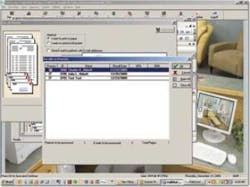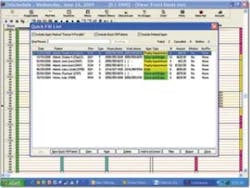The Paperless Schedule
How the computerized system benefits time management
by Jana Berghoff, RDH
During my time as a practicing hygienist, I was fortunate to experience the many rewards offered by the hygiene field. However, I also experienced many of the challenges that come with the profession, and this helped me gain insight into the needs of today’s hygienists. One of the main challenges I experienced in practice was working with a paper schedule, and this remains a frustration for many hygienists. Paper schedules can lead to inefficient communication in the office and lead to a number of bigger problems.
While there are many advantages to adopting a computerized system in the dental office, improved scheduling is one of the main benefits of making the switch. Additionally, because scheduling is the platform for so much of the office workflow, a smooth running scheduling system can positively impact many other areas of the practice.
Communication with the front desk
With paper scheduling, there are many opportunities for miscommunication or inefficiency in the office. If the front desk person adds a new patient to the hygienist’s schedule but forgets to add it to the hygienist’s paper schedule, the hygienist has no way of knowing that the patient is there. In another scenario, if a patient calls to inform the office that he or she is running late, it is often difficult for the front desk to efficiently alert the hygienist. In many instances, a hygienist appreciates and can make good use of extra time with his or her patients, but if the hygienist doesn’t know there’s extra time in the schedule, these valuable opportunities may be wasted.
In terms of time management, the ability to see scheduling changes live from the treatment room, such as with the “OnSchedule” feature from Patterson EagleSoft Practice Management Software, is vital for the hygienist. Computerized scheduling makes it easy to maintain a short call list of patients who would like to be treated sooner than their scheduled appointments. For hygienists who are paid based on their production or held to a certain level of production, efficiently running a short call list can make an appreciable difference. Without a computer, normally only the front desk person can manage this list, but computerized scheduling also allows hygienists to access this information. Also, a computerized schedule can automatically remove a patient from the list once he or she gets a new appointment, and there is often confusion regarding rescheduled appointments with paper scheduling.
The changing hygiene treatment options can also cause communication issues when scheduling is left to the front desk. There are now insurance codes based not on a whole quadrant of teeth but on more specific numbers and areas of teeth, and the reception team may not schedule correctly for these time consuming treatments. Allowing hygienists to quickly view their schedules and make their own appointments helps ensure these treatments are accurately planned, or that any miscalculation by the front desk is quickly corrected.
Building your personal production
The ability to schedule their own appointments gives hygienists much needed control and flexibility. For example, hygienists who know that certain patients’ appointments often run long can allow extra time in the schedule, or avoid booking one of these patients right next to the other. As we know, time can vary in even the most basic services, because not all prophies are created equal. Hygienists who know their patients well can properly adjust their schedules to accommodate them better and allow for breaks between challenging patients. I have also noticed that hygienists who can schedule their own time are more apt to schedule additional services, such as nutritional counseling and patient education, that the front desk may not be aware of.
With practice management software, hygienists feel empowered to take more control of their own schedules and production. An easy-to-use reporting feature, such as the “Reports” feature from EagleSoft, lets staff members create reports about their patients, and allows hygienists to search for patients and follow up or contact them as necessary. For instance, if a patient has completed only one step in a multistep treatment, the hygienist can contact the patient to check on his or her progress. Also, the records of family members can be easily linked together. This allows the hygienist to note, for example, when a mother’s children are due for appointments, during the mother’s appointment. She can then ask the mother if she would like to schedule any appointments for her children.
The ability to easily view a patient’s record can help hygienists concentrate their practice-building efforts where they are most useful. Many hygienists like to suggest optional services such as whitening, but may do this without realizing a patient has outstanding bills with the practice. Practice management software enables the hygienist to see factors such as these and suggest only appropriate services.
In addition to proactively contacting patients, hygienists can work on building their personal patient base at the end of every appointment. With the ability to schedule a patient’s next appointment from the treatment room, a hygienist can personally make sure that the patient is scheduled to see him or her again. Furthermore, many hygienists find that patients are more likely to book a future appointment when they are asked by the dental team in the treatment room rather than by the receptionist at the front desk.
Software can be used to find patients on short notice.
Helping the practice run smoothly
The improved interoffice communication that comes with scheduling software can help the office run better in many ways. For instance, EagleSoft has a feature that allows users to view only the doctor’s schedule and their own, which can greatly simplify the scheduling screen. Users can then quickly revert back to a view that shows the entire office’s schedules, which is useful for further coordination. For instance, if a parent visits the office with a number of children and wants them all to be seen at the same time, a hygienist can quickly view the entire staff’s availability. Or, if one hygienist is running late with a patient, he or she she can easily send an instant message via the computer to ask another staff member to begin the next appointment by taking X-rays.
An additional feature available with this software is the “ideal day template,” which allows a hygienist to communicate preferences and scheduling needs with the front desk. Some hygienists prefer to perform scaling and root planing early in the day, or want to make sure that time is set aside each day for a certain type of appointment. Scheduling software enables each staff member to create a customized schedule unique to each team member.
Practice management software allows the schedule to serve as the starting point for access to any other necessary information. Hygienists can easily click into patients’ records to locate their history and notes, rather than taking more time to consult a paper chart. The computerized schedule can also display the date of a patient’s last X-rays directly in the appointment box, putting this important information where it can be easily seen. Additionally, scheduling software can help hygienists mask patient information from the screen, allowing them to display their schedules in the treatment room while maintaining confidentiality.
Dental hygienists are an important influence in the dental office regarding technology and efficiency. While switching to a computerized schedule or a paperless office may seem daunting for some offices, the benefits in efficiency, production, and communication are too great to ignore. Even offices that are currently using scheduling software may find there are features they are not taking full advantage of, so it is worth exploring all the capabilities of any existing system. Being proactive about scheduling can be a big help for hygienists in improving patient relationships and advancing their careers.
Jana Berghoff, RDH, is a Patterson Technology representative with more than 30 years of experience in the dental profession. Initially trained as a dental hygienist at Northwestern University School of Dentistry in Chicago, she spent time in the clinical setting learning the ropes of patient care. She soon found herself moving into office/staff management positions. As an office administrator, she worked with and was trained on several different dental software programs and found she liked working with computers. She refocused her career and started working with Patterson Dental.



